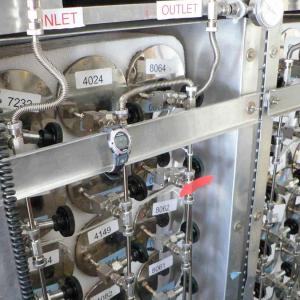The UC-Irvine research group collected whole air samples aboard the NASA DC-8 aircraft during the summer 2019 NASA Fire Influence on Regional to Global Environments Experiment - Air Quality (FIREX-AQ) field mission. More than 70 trace gases were identified and quantified at our Irvine laboratory, including C2-C10 NMHCs, C1-C2 halocarbons, C1-C5 alkyl nitrates, and selected sulfur compounds using our established technique of airborne whole air sampling followed by laboratory analysis using gas chromatography (GC) with flame ionization detection (FID), electron capture detection (ECD), and mass spectrometric detection (MSD). Our experimental procedures build on those that have been successfully employed for numerous prior NASA field missions, for example PEM Tropics A and B, TRACE-P, INTEX-A and B, ARCTAS, DC-3, SEAC4RS, ATom, KORUS-AQ, FIREX-AQ, and SARP.
Whole Air Sampler
Instrument Type
Measurements
Aircraft
Recent Missions
Point(s) of Contact
(POC; PI),
(Co-I),
(Co-I),
(Co-I),
(Co-I),
(Prev PI)
Range of Measurement
In situ
Notes
WAS measures NMHC's and halocarbons using sample collection followed by in-lab analysis
Mission-Specific Writeups
Document
Publications
Blake, N.J., et al. (2003), NMHCs and halocarbons in Asian continental outflow during TRACE-P: Comparison to PEM-West B, J. Geophys. Res., 108, 8806, doi:10.1029/2002JD003367.
Blake, N.J., et al. (2003), Latitudinal, vertical, and seasonal variations of C1-C4 alkyl nitrates in the troposphere over the Pacific Ocean during PEM-Tropics A and B: Oceanic and continental sources, J. Geophys. Res., 108, 10.
Blake, N.J., et al. (2001), Large scale latitudinal and vertical distributions of NMHCs and selected halocarbons in the troposphere over the Pacific Ocean during the March-April 1999 Pacific Exploratory Expedition (PEM-Tropics B), J. Geophys. Res., 106, 32627-32644.
Blake, N.J., et al. (2003), Carbonyl sulfide (OCS) and carbon disulfide (CS2): Large scale distributions and emissions from Asia during TRACE-P, J. Geophys. Res., doi:10.1029/2003JD004259.
Blake, N.J., et al. (2008), Carbonyl sulfide (OCS): Large-scale distributions over North America during INTEX-NA and relationship to CO2, J. Geophys. Res., 113, D09S90, doi:10.1029/2007JD009163.
Colman, J.J., et al. (2001), Description of the analysis of a wide range of volatile organic compounds in whole air samples collected during PEM-Tropics A and B, Anal. Chem., 73, 3723-3731.
Simpson, I.J., et al. (2001), Aircraft measurements of dimethyl sulfide (DMS) using a whole air sampling technique, J. Atmos. Chem., 39, 191-213.
Simpson, I.J., et al. (2002), A biomass burning source of C1-C4 alkyl nitrates, Geophys. Res. Lett., 29, doi:10.1029/2002GL016290.
Simpson, I.J., et al. (2003), Production and evolution of selected C2-C5 alkyl nitrates in tropospheric air influenced by Asian outflow, J. Geophys. Res., 108, 8808, doi:10.1029/2002JD002830.
Simpson, I.J., et al. (2003), Airborne measurements of cirrus-activated C2Cl4 depletion in the upper troposphere with evidence against Cl reactions, Geophys. Res. Lett., 30, 2025, doi:10.1029/2003GL017598.
Tyler, S.C., et al. (1999), Carbon isotopic composition of atmospheric methane: A comparison of surface level and upper tropospheric air, J. Geophys. Res., 104, 13895-13910.
Lamb, K.D., et al. (2018), Estimating Source Region Influences on Black Carbon Abundance, Microphysics, and Radiative Effect Observed Over South Korea, J. Geophys. Res., 123, 13,527-13,548, doi:10.1029/2018JD029257.
Barletta, B., et al. (2019), ATom: L2 Halocarbons and Hydrocarbons from the UC-Irvine Whole Air Sampler (WAS), Ornl Daac, doi:10.3334/ORNLDAAC/1751.
Chen, X., et al. (2019), On the sources and sinks of atmospheric VOCs: an integrated analysis of recent aircraft campaigns over North America, Atmos. Chem. Phys., 19, 9097-9123, doi:10.5194/acp-19-9097-2019.
Tang, W., et al. (2019), Source Contributions to Carbon Monoxide Concentrations During KORUS‐AQ Based on CAM‐chem Model Applications, J. Geophys. Res..
Murphy, D.M., et al. (2018), An aerosol particle containing enriched uranium encountered in the remote T upper troposphere, Journal of Environmental Radioactivity, 184–185, 95-100, doi:10.1016/j.jenvrad.2018.01.006.
Groups
Disclaimer: This material is being kept online for historical purposes. Though accurate at the time of publication, it is no longer being updated. The page may contain broken links or outdated information, and parts may not function in current web browsers. Visit https://espo.nasa.gov for information about our current projects.


